

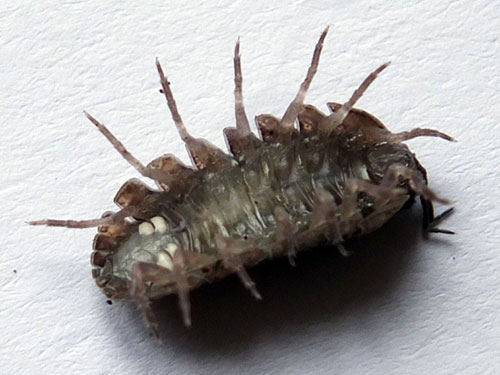
Armadillidium vulgare showing uropods flush with body and single pairs of legs on each segment
Photo: Derek Binns
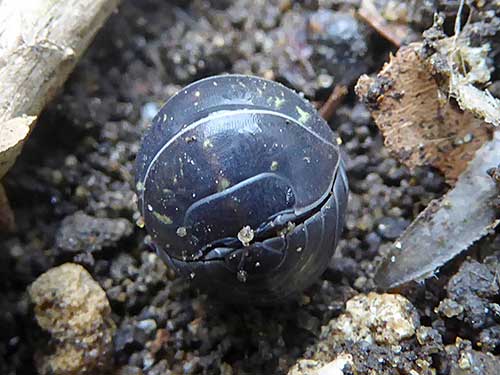
Armadillidium vulgare enrolled into tight ball
Photo: Andrew Dyer
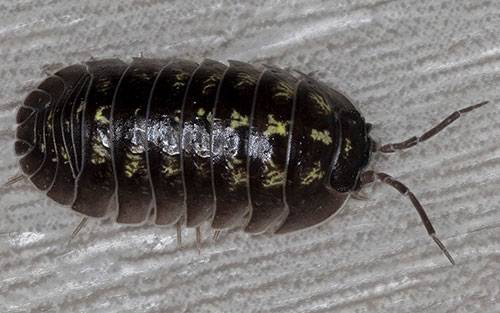
Armadillidium depressum showing its flared pleon and triangular telson
Photo: Bill Welch
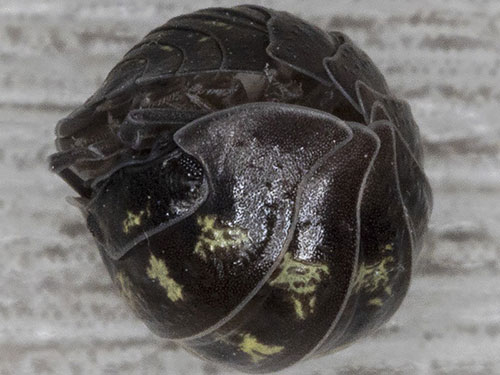
Enrolled Armadillidium depressum showing small gap
Photo: Bill Welch
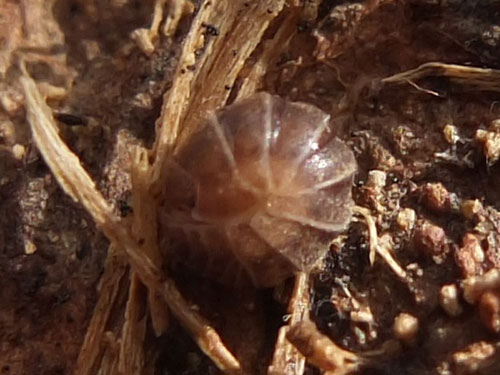
Eluma caelata, only the fifth specimen to be recorded in Sussex
Photo: Brad Scott
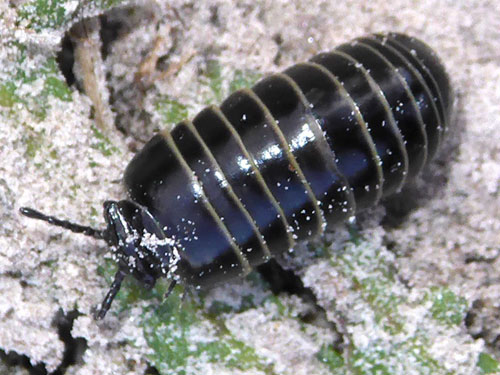
Glomeris marginata showing differences from Armadillidium spp.
Photo: Mike Funnell
The Armadillidiidae or “pill woodlice” is a family of large woodlice, which are relatively straightforward to identify and can be found in suitable habitat all year round. Members of the family are characterised by their ability enrol (volvate) their bodies into an almost perfect sphere or pill as a means of defending themselves against predation. Their final body segment (telson) is triangular, tapering towards the tail and is flanked on either side by uropods, projections which terminate flush with the end of the body. In all other woodlice (except for the Armadillidae where the telson is described as hour-glass shaped) the uropods are much longer and project past the end of the body.
The British Myriapod and Isopod Group (BMIG) website lists seven species of Armadillidiidae that occur in the UK (as well as one, still to be described species). Of these we have records of five species in East and West Sussex. The commonest in Sussex is the Common Pill Woodlouse, Armadillidium vulgare. This species is relatively simple to identify being, usually, slate grey or occasionally a reddish colour or mottled in appearance, up to 18 mm in length and capable of enrolling into a tight ball without any gap. The second most recorded Sussex species is A. nasatum, smaller than A. vulgare and unable to enrol into a tight ball, leaving a gap with its antennae protruding. It has longitudinal stripes, a slightly translucent appearance and distinctive, protruding scutellum. The third of the commoner species is A. depressum. Similar in size, or even slightly larger than A. vulgare, A. depressum can be distinguished by its pleon which is flared or outward curving. A. depressum also leaves a small gap when it enrols. The SxBRC has three records of A. pulchellum an attractively patterned species, all from Black Down in the far northwest of West Sussex. Two of these were from 1998 (where it is described as “numerous among tall, bushy heather”) and there is one record from 2011. The final Sussex species is Eluma caelata, a naturalised non-native species that is very similar to A. vulgare but easily identified by its prominent black ‘beady’ eye structures which are composed of single ommatidia. None of the members of the Armadillidiidae recorded in Sussex has a designation and all are listed as Least Concern by the IUCN.
All these species are detritivores that can be found in leaf litter and under stones or fallen branches. A. vulgare feeds at night and can frequently be seen foraging on walls and tree trunks. A. depressum is often found in gardens and disturbed grassland and is mildly synanthropic. They prefer drier conditions than most other woodlice and also, although usually widely distributed, have a preference for base-rich soils.
The two species yet to be recorded in Sussex are Armadillidium pictum and the Beach Pill Woodlouse, A. album. The former is considered one of Britain’s rarest woodlice and is a species of rocky habitats, such as scree or rock pavement within or near to woodland. A. album is found on or within strandline litter and, owing to the difficulty finding it because of its habit of burrowing into the sand, is probably more widespread than records would suggest.
The closely related family, Armadillidae has three species all of which are relatively small woodlice and none of which have been recorded in Sussex.
All of these can easily be distinguished from the similar Pill Millipede Glomeris marginata which is black and glossy, has a large single tergite at its tail end and pale edges to its tergites giving at a laterally striped appearance. It also has four legs per segment as opposed to two per segment in woodlice.
What is extraordinary, given how very familiar animals are, is how few records we actually have in the SxBRC database. In total we have 465 records only 351 of which are from this century. 272 of these are of A. vulgare so more records, especially of the less abundant species would be much appreciated.
Ideally records should be submitted through iRecord and the BMIG particularly asks that records are accompanied with photograph(s) to help with verification and also for as much relevant ecological information as possible to be included.
Every month it is our aim to highlight a species that is “in-season” and, although not necessarily rare or difficult to identify, has been highlighted by our local recording groups as being somewhat under-recorded and for which new records would therefore be welcomed.
If you or your recording group are aware of species such as this then please contact Bob Foreman.